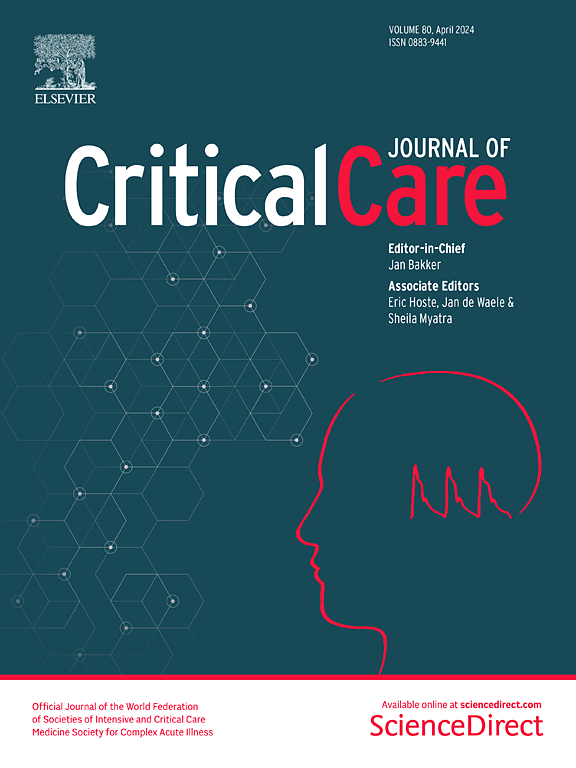D-PRISM: a global survey-based study to assess diagnostic and treatment approaches in pneumonia managed in intensive care
IF 8.8
1区 医学
Q1 CRITICAL CARE MEDICINE
引用次数: 0
Abstract
Pneumonia remains a significant global health concern, particularly among those requiring admission to the intensive care unit (ICU). Despite the availability of international guidelines, there remains heterogeneity in clinical management. The D-PRISM study aimed to develop a global overview of how pneumonias (i.e., community-acquired (CAP), hospital-acquired (HAP), and Ventilator-associated pneumonia (VAP)) are diagnosed and treated in the ICU and compare differences in clinical practice worldwide. The D-PRISM study was a multinational, survey-based investigation to assess the diagnosis and treatment of pneumonia in the ICU. A self-administered online questionnaire was distributed to intensive care clinicians from 72 countries between September to November 2022. The questionnaire included sections on professional profiles, current clinical practice in diagnosing and managing CAP, HAP, and VAP, and the availability of microbiology diagnostic tests. Multivariable analysis using multiple regression analysis was used to assess the relationship between reported antibiotic duration and organisational variables collected in the study. A total of 1296 valid responses were collected from ICU clinicians, spread between low-and-middle income (LMIC) and high-income countries (HIC), with LMIC respondents comprising 51% of respondents. There is heterogeneity across the diagnostic processes, including clinical assessment, where 30% (389) did not consider radiological evidence essential to diagnose pneumonia, variable collection of microbiological samples, and use and practice in bronchoscopy. Microbiological diagnostics were least frequently available in low and lower-middle-income nation settings. Modal intended antibiotic treatment duration was 5–7 days for all types of pneumonia. Shorter durations of antibiotic treatment were associated with antimicrobial stewardship (AMS) programs, high national income status, and formal intensive care training. This study highlighted variations in clinical practice and diagnostic capabilities for pneumonia, particularly issues with access to diagnostic tools in LMICs were identified. There is a clear need for improved adherence to existing guidelines and standardized approaches to diagnosing and treating pneumonia in the ICU. Trial registration As a survey of current practice, this study was not registered. It was reviewed and endorsed by the European Society of Intensive Care Medicine.D-PRISM:一项基于调查的全球研究,旨在评估重症监护中肺炎的诊断和治疗方法
肺炎仍然是全球关注的重大健康问题,尤其是需要入住重症监护室(ICU)的患者。尽管已有国际指南,但在临床管理方面仍存在差异。D-PRISM 研究旨在对重症监护病房如何诊断和治疗肺炎(即社区获得性肺炎 (CAP)、医院获得性肺炎 (HAP) 和呼吸机相关肺炎 (VAP))进行全球概述,并比较全球临床实践的差异。D-PRISM 研究是一项基于调查的多国研究,旨在评估重症监护病房的肺炎诊断和治疗情况。2022 年 9 月至 11 月期间,该研究向 72 个国家的重症监护临床医生发放了一份自填式在线问卷。问卷包括专业概况、当前诊断和管理 CAP、HAP 和 VAP 的临床实践以及微生物诊断测试的可用性等部分。采用多元回归分析法进行多变量分析,以评估报告的抗生素使用时间与研究中收集的组织变量之间的关系。研究共收集到 1296 份来自 ICU 临床医生的有效回复,这些回复分布于中低收入国家(LMIC)和高收入国家(HIC),其中中低收入国家的受访者占 51%。诊断过程存在差异,包括临床评估(30% 的受访者(389 人)不认为放射学证据是诊断肺炎的必要条件)、微生物样本的不同采集以及支气管镜检查的使用和实践。在低收入和中低收入国家,微生物诊断的使用率最低。所有类型肺炎的抗生素治疗时间一般为 5-7 天。抗生素治疗时间较短与抗菌药物管理(AMS)计划、高国民收入状况和正规的重症监护培训有关。这项研究强调了肺炎临床实践和诊断能力方面的差异,尤其发现了低收入国家在获取诊断工具方面存在的问题。在重症监护病房诊断和治疗肺炎时,显然需要更好地遵守现有指南和标准化方法。试验注册 作为对当前实践的调查,本研究未进行注册。欧洲重症医学会已对该研究进行了审查并表示认可。
本文章由计算机程序翻译,如有差异,请以英文原文为准。
求助全文
约1分钟内获得全文
求助全文
来源期刊

Critical Care
医学-危重病医学
CiteScore
20.60
自引率
3.30%
发文量
348
审稿时长
1.5 months
期刊介绍:
Critical Care is an esteemed international medical journal that undergoes a rigorous peer-review process to maintain its high quality standards. Its primary objective is to enhance the healthcare services offered to critically ill patients. To achieve this, the journal focuses on gathering, exchanging, disseminating, and endorsing evidence-based information that is highly relevant to intensivists. By doing so, Critical Care seeks to provide a thorough and inclusive examination of the intensive care field.
 求助内容:
求助内容: 应助结果提醒方式:
应助结果提醒方式:


